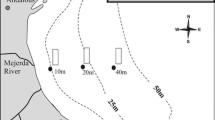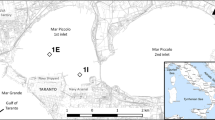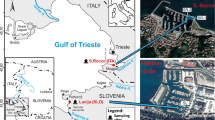Abstract
Deltaic sediments are important for biogeochemical metal cycling since they are hotspots for metal inputs. In addition, they are potential sites for diagenetic processes leading to either the burial of inorganic contaminants or their release. Diffusive fluxes of certain metals (Fe, Mn, Pb, Zn, Cu and Cd) in the sediments of the Mejerda River Delta (MRD) (Gulf of Tunis, Tunisia) were quantified by modeling the available concentration profiles in the pore water. The metals’ burial and sedimentation fluxes were also calculated using both the asymptotic concentrations of available metal profiles and sediment trap results. These fluxes were assembled with the exchange fluxes at the sediment-water interface in order to develop complete metal transfer budgets. The results showed that budgets of Cu and Zn are almost neutral. The sediment appears to be a good trap for iron since its average burial flux at the three studied stations is about 332.6 g m−2 year−1. Organic matter degradation, carbonate dissolution, and oxyhydroxide reduction are the main mechanisms which accelerate the release of metals associated with the suspended particle matter once they reach the pore water in the seabed.











Similar content being viewed by others
References
Aleya, L., Béjaoui, B., Dhib, A., Ziadi, B., Bellekhal, F., Helali, M.A., Khedhri, I. Oueslati, W. et al. (2019). World seas: an environmental evaluation volume I: Europe, the Americas and West Africa. Chapter 10. Tunisia. Edited by Charles Sheppard. Elsevier Amsterdam, 261–283.
Belkhir, M., & Hadj Ali, S. (1982). Notion d’hydrologie comparée dans le lac de Tunis et le golfe de Tunis. Bulletin de l'Institut national scientifique et technique d'océanographie et de pêche, 10, 5–26.
Ben Mna, H., Oueslati, W., Helali, M. A., Zaaboub, N., Added, A., & Aleya, L. (2017). Distribution and assessment of heavy metal toxicity in sediment cores from Bizerte lagoon, Tunisia. Environmental Monitoring and Assessment, 189, 356. https://doi.org/10.1007/s10661-017-6073-5.
Bender, M. L., & Gagner, C. (1976). Dissolved copper, nickel and cadmium in the Sargasso Sea. Journal of Marine Research, 34, 32–339.
Benoit, G., Oktay-Marshall, S. D., Cantu, A., Hood, E. M., Coleman, C. H., Corapcioglu, M. O., & Santschi, P. H. (1994). Partitioning of Cu, Pb, Ag, Zn, Fe, AI and Mn between filter-retained particles, colloids, and solution in six Texas estuaries. Marine Chemistry, 45, 307–336.
Berg, P., Risgaard-Petersen, N., & Rysgaard, S. (1998). Interpretation of measured concentration profiles in sediment pore water. Lirnnology and Ocennography, 437, 1500–1510.
Berner, R. A. (1980), Early diagenesis, a theoretical approach. Princeton Series in.
Boudreau B. P. (1997) Diagenetic models and their implementation. Springer.
Boyle, E. A., Sclater, F., & Edmond, J. M. (1976). On the marine geochemistry of cadmium. Nature, 263, 42–44.
Chester, R. (2000). Marine geochemistry (p. 506p). London: Academic Press.
Dang, D. H. (2014). Dynamique sédimentaire et mécanismes de transferts des métaux/métalloïdes dans un écosystème contaminé : la Rade de Toulon. Thèse Chimie de l’environnement, Université de Toulon. p283.
El Arrim, A. (1996). Etude d’impact de la dynamique sédimentaire et des aménagements Sur la stabilité du littoral du golfe de Tunis. Doctorat de spécialité 203p.
Essoni, N. (1998). Etude de la dynamique des sels nutritifs et des métaux lourds en Relation avec la sedimentologie et l’hydrodynamique dans le large du golfe de Tunis. Thèse de doctorat en Géologie. Université De Tunis II. 229p.
Fernandez, H. M. (1997). Heavy metals distribution in sediments and ecological risk assessment: The role of diagenetic process in reducing metal toxicity in bottom sediments. Environmental Pollution, 97, 317–325.
Gobeil, C., Macdonald, R. W., & Sundby, B. (1997). Diagenetic separation of cadmium and manganese in suboxic continental margin sediments. Geochimica et Cosmochimica Acta, 61, 4647–4654.
Hassen, N. H. 2019 (n.d.) Approche intégrée pour le contrôle de la pollution marine utilisant les techniques nucléaires. PhD in progress.
Helali, M. A. (2010). Géochimie des sédiments marins de surface dans le delta de l’Oued Mejerda. Mastère en Géologie. Université De Tunis-El Manar. 94p.
Helali, M. A. (2015). Bilan de transfert des métaux lourds dans des milieux marins soumis aux apports d’origines naturelles et anthropiques :Cas du delta de l’Oued Mejerda. Thèse de doctorat. Université Tunis El Manar. p 281.
Helali, M. A., Oueslati, W., Zaaboub, N., Added, A., & Abdeljaouad, S. (2013). Geochemistry of marine sediments in the Mejerda River delta, Tunisia. Chemical Speciation and Bioavailability, 25(4), 247–257.
Helali, M. A., Zaaboub, N., Oueslati, W., Added, A., & Aleya, L. (2015). Diagenetic processes and sedimentewater exchanges of heavy metals in the Mejerda River Delta (Gulf of Tunis). Environmental Earth Science, 74, 6665–6679. https://doi.org/10.1007/s12665-015-4667-1.
Helali, M. A., Oueslati, W., Zaaboub, N., Added, A., & Aleya, L. (2016a). Bioavailability and assessment of heavy metal pollution in sediment cores off the Mejerda River Delta (Gulf of Tunis): How useful is a multiproxy approach? Marine Pollution Bulletin., 105, 215–226. https://doi.org/10.1016/j.marpolbul.2016.02.027.
Helali, M. A, Oueslati, W., Zaaboub, N., Added A., & Aleya, L. (2016b). Chemical speciation of Fe, Mn, Pb, Zn, cd, cu, co, Ni and Cr in the suspended particulate matter off the Mejerda River Delta (gulf of Tunis, Tunisia). Journal of African Earth Science. https://doi.org/10.1016/j.jafrearsci.2016.02.013.
Helali, M. A., Zaaboub, N., Oueslati, W., Added, A., & Aleya, L. (2016c). Suspended particulate matter fluxes along with their associated metals, organic matter and carbonates in a coastal Mediterranean area affected by mining activities. Marine Pollution Bulletin, 104, 171–181.
Helland, A., & Torgeir, B. (2002). Transport and sedimentation of Cu in a microtidal estuary, SE Norway. Marine Pollution Bulletin, 44, 149–155.
Jones, B., & Turki, A. (1997). Distribution and speciation of heavy metals in surficial sediments from the tees estuary, north-east England. Marine Pollution Bulletin, 34, 768–779.
Klinkhammer, G. P. (1980). Early diagenesis in sediments from the eastern equatorial Pacific. II. Pore water metal results. Earth and Planetary Science Letters, 49, 81–101.
Knauer, G. A., & Martin, J. H. (1981). Phosphorus–cadmium cycling in Northeast Pacific waters. Journal of Marine Research, 39, 65–76.
Kouki, A. (1984). Contribution à l’étude dynamique sédimentaire dans le golfe de Tunis. Thèse de 3éme cycle. Faculté des sciences de Tunis. 167p.
Li, Y. H., & Gregory, S. (1974). Diffusion of ions in sea water and in deep-sea sediments. Geochimica et Cosmochimica Acta, 38, 703–714.
Li, X. D., Shen, Z. G., Wai, O. W. H., & Li, Y. S. (2001). Chemical forms of Pb, Zn, and Cu in the sediment profiles of the Pearl River estuary. Marine Pollution Bulletin, 42, 215–223.
Ma, L. Q., & Rao, G. N. (1997). Chemical forms of cadmium, copper, nickel, and zinc in contaminated soils. Journal of Environmental Quality, 26, 259–264.
Martins, V. A., Frontalini, F., Tramonte, K. M., Figueira, R. C. L., Miranda, P., Sequeira, C., Fernández-Fernández, S., Dias, J. A., Yamashita, C., Renó, R., Laut, L. L. M., Silva, F. S., Rodrigues, M. A. C., Bernardes, C., Nagai, R., Sousa, S. H. M., Mahiques, M., Rubio, B., Bernabeu, A., Rey, D., & Rocha, F. (2013). Assessment of the health quality of Ria de Aveiro (Portugal): heavy metals and benthic foraminifera. Marine Pollution Bulletin, 70, 18–33.
Mezouzi, R. (2005). Géochimie des métaux lourds dans les sédiments superficiels du delta de Mejerda. DEA. Faculté Des Sciences De Tunis. 68p.
Moldenhauer, K. M., Christoph, Z., & Dominik, F. (2007). Heavy metals as indicators for Holocene sediment provenance in a semi-arid Mediterranean catchment in northern Tunisia. Quaternary International, 189, 129–134.
Nriagu, J. O. (1988). A silent epidemic of environmental metal poisoning? Environmental Pollution, 50, 139–161.
Oueslati, A. (1992). Sur l’évolution de l’environnement côtier en Tunisie depuis l’occupation néolithique. Cahiers du CERES, 91–104.
Oueslati, A. (1993). Les côtes de la Tunisie, géomorphologie et environnement et aptitude à l’aménagement. Pub. Université de Tunis I. V. XXXIV. 387 p.
Oueslati, W. (2011). Cycles biogéochimiques des métaux lourds dans les sédiments marins de la lagune de Ghar El Melh. Thèse de doctorat. Université Tunis El Manar. p 271.
Oueslati, W., Added, A., & Abdeljaoued, S. (2010a). Vertical profiles of simultaneously extracted metals (SEM) and acid-volatile sulfide in a changed sedimentary environment: Ghar El Melh lagoon, Tunisia. Soil and Sediment Contamination, 19, 696–706.
Oueslati, W, Added, A., & Abdeljaoued, S. (2010b). Evaluation of metal contamination in a changed sedimentary environment: Ghar El Melh lagoon, Tunisia. Geochemical and statistical approaches. Chemical Speciation and Bioavailability, 22, 227–240.
Oueslati, W., Zaaboub, N., Helali, M. A., Ennouri, R., Martins, M. V., Dhib, A., Galgani, F., El Bour, M., Added, A., & Aleya, L. (2017). Trace element accumulation and elutriate toxicity in surface sediment in northern Tunisia (Tunis gulf, southern Mediterranean). Marine Pollution Bulletin, 116(1–2), 216–225.
Oueslati, W., Helali, M. A., Zaaboub, N., Sebei, A., Added, A., & Aleya, L. (2018). Sulfide influence on metal behavior in a polluted southern Mediterranean lagoon: implications for management. Environmental Science and Pollution Research, 25(3), 2248–2264.
Paskoff, R. (1983). L’érosion des plages. La recherche, 140, 20–28.
Paskoff, R., & Trousset, P. (1992). L’ancienne baie d’Utique, du témoignage des textes à celui images satellitaires.
Pimienta, J. (1959). Le cycle pliocène-actuel dans les bassins paraliques de Tunis. Mémoires de la Soc. Géol. de France, nouvelle série, 85, 176 p.
Ramos, L., Fernandez, M., & Gonzalez, M. J. (1999). Sequential fractionation of copper, lead, cadmium and zinc in soil from or near Donana national park. Journal of Environmental Quality, 23, 50–57.
Rosenthal, Y., Lam, P., Boyle, E. A., & Thomson, J. (1995). Authigenic cadmium enrichments in suboxic sediments: precipitation and post depositional mobility. Earth and Planetary Science Letters, 132, 99–111.
Sánchez-Chardi, A., López-Fuster, M. J., & Nadal, J. (2007). Bioaccumulation of lead, mercury, and cadmium in the greater white-toothed shrew, Crocidura russula, from the Ebro Delta (NE Spain): Sex- and age-dependent variation. Environmental Pollution, 145, 7–14.
Santos-Echeandia, J., Prego, R., Cobelo-GarcÌa, A., & Millward, G. E. (2009). Porewater geochemistry in a Galician Ria, NW Iberian Peninsula.: implications for benthic fluxes of dissolved trace elements ,Co, Cu, Ni, Pb, V, Zn. Marine Chemistry, 117, 77–87.
Schijf, J., Debaar, H. J. W., & Millero, F. J. (1995). Vertical distributions and speciation of dissolved rare earth elements in the anoxic brines of Bannock Basin, eastern Mediterranean Sea. Geochimica et Cosmochimica Acta, 59(16), 3285–3299.
Shaw, T. J., Gieskes, J. M., & Janke, R. A. (1990). Early diagenesis in differing depositional environments: the response of transition metals in pore water. Geochimica et Cosmochimica Acta, 54, 1233–1246.
Szefer, P. (1991). Interphase and trophic relationships of metals in a southern Baltic ecosystem. Science of the Total Environment, 101, 201–215.
Telford, W. M., Geldart, L. P., & Sheriff, R. A. (1990). Applied geophysics, 2nd edition: Cambridge University press.
Tessier, E. (2012). Diagnostic de la contamination sédimentaire par les metaux/metalloids dans la rade de Toulon et mécanismes contrôlant leur mobilité. Thèse Chimie de l’environnement, Université du Sud Toulon Var. p291.
Tessier, A., Campbell, P. G. C., & Bisson, M. (1979). Sequential extraction procedure for speciation of particulate trace metals. Analytical Chemistry, 51, 884–851.
Welch, S., Lyons, W. B., & Kling, C. A. (1990). A co-precipitation technique for determining trace metal concentrations in iron-rich saline solutions. Environmental Science & Technology, 11, 141–144.
Wen, X., & Allen, H. E. (1999). Mobilization of heavy metals from Le An river sediment. Science of Total Environment, 227, 101–108.
Westerlund, S. F. G., Anderson, L. G., Hall, P. O. J., Iverfeldt, A., Van Der Loeff, M. M. R., & Sundby, B. (1986). Benthic fluxes of cadmium, copper, nickel, zinc and lead in the coastal environment. Geochimica et Cosmochimica Acta, 50, 1289–1296.
Zaaboub, N., Oueslati, W., Helali, M. A., Abdeljaouad, S., Huertas, J. F., & Galindo, A. L. (2014). Trace elements in different marine sediment fractions of the Gulf of Tunis (Central Mediterranean Sea). Chemical Speciation and Bioavailability, 26, 1–12.
Zhou, H. Y., Cheung, R. Y. H., & Wong, M. H. (1998). Metal concentrations in sediments and Tilaoya collected from inland waters of Hong Kong. Water Research, 32, 3331–3340.
Acknowledgements
This study was made possible by a Franco-Tunisian cooperation project (Chrono-Environment Laboratory, Besançon, France, UMR CNRS 6249; Laboratory of Geosciences, Mineral, Energetic Resources and Environment, Faculty of Sciences of Tunis, Tunisia). We would like to thank all concerned for their participation and contributions. We acknowledge the analytical support provided by the following laboratories: Mineral Resources and Environment, Faculty of Sciences of Tunis; and Laboratory of Oceanography and Sedimentology, National Institute of Marine Sciences and Technology, Tunis. We especially thank Professor Filip Meysman of Antwerp University, Belgium, whose fruitful discussions of our results were of great help.
Author information
Authors and Affiliations
Corresponding author
Additional information
Publisher’s note
Springer Nature remains neutral with regard to jurisdictional claims in published maps and institutional affiliations.
Rights and permissions
About this article
Cite this article
Oueslati, W., Helali, M.A., Zaaboub, N. et al. Metal transfer budgets in a Mediterranean marine environment subjected to natural and anthropogenic inputs: case of the Mejerda River Delta (Gulf of Tunis, northern Tunisia). Environ Monit Assess 191, 386 (2019). https://doi.org/10.1007/s10661-019-7521-1
Received:
Accepted:
Published:
DOI: https://doi.org/10.1007/s10661-019-7521-1




